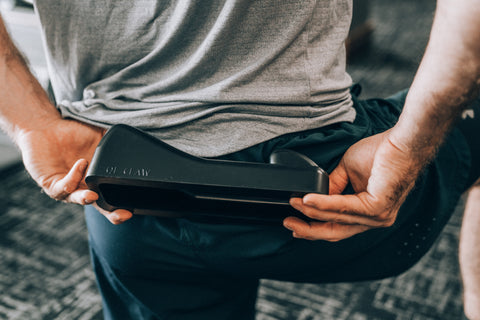Where Does Pain At Top Of Buttock Crack Come From?

Cause #1 - Coccydynia
Coccydynia, or discomfort or inflammation of the coccyx (tailbone), is a common source of pain buttock pain while sitting.
The coccyx is located at the base of the spine, slightly above the buttock crack, and can become painful after extended sitting, injury, or strain.
Sitting on uncomfortable surfaces or for extended periods of time can put excessive pressure directly on the tailbone, causing pain.
Cause #2 - Cysts
Another potential reason is pilonidal cysts, defined as fluid-filled sacs or abscesses that form around the top of the buttock crack as a result of ingrown hairs or skin detritus.
These cysts can get infected, resulting in redness, swelling, and pain, particularly when sitting or applying pressure to the area.
Cysts are a less common cause of pain at top of buttock crack, but non-the-less something to be cognizant of.
Cause #3 - Muscle Tightness
Now we get into the more common sources of buttock pain when sitting.
One of the those being muscle tightness.
This is where glute muscles surrounding the tailbone become weak and tight, resulting in pain.
The three most popular hip/buttock muscles involved in pain at the top of the buttock crack include 1) Piriformis, 2) Gluteus Medius, and 3) Gluteus minimus.
Additionally, nerve compression can also cause pain at top of buttock crack when sitting.
The sciatic nerve runs through the buttocks and down the legs. A common cause of sciatic nerve pain is piriformis syndrome.
Each muscle involved in buttock and lower back pain has a different function and trigger point—Trigger points are irritable contraction knots in muscles that can cause pain throughout the body.
Locating and releasing said trigger points is an awesome way to find relief and relieve tension.

Buttock Muscle Pain Pattern [1]
More Potential Causes
Muscle strain, bad posture, or back issues such as herniated discs can all cause pain in the same place by affecting the muscles and nerves surrounding the lower vertebral column and pelvis, resulting in pain radiating to the tailbone.

Finding Relief
Treating Coccydynia
The initial step in treating coccydynia is to reduce pressure on the tailbone.

Using a cushioned, yoga ball, or circular pillow when sitting can help relieve direct strain on the tailbone.
Adjusting the way you sit by sitting more upright and equally distributed might also be beneficial.
Ibuprofen and acetaminophen, both over-the-counter pain medications, can help to reduce inflammation and pain.
As the discomfort continues, try exercises that build up the hip and core muscles, as well as mild stretches, and deep tissue massage to surrounding muscles.
Treating Cysts
Proper hygiene and treatment are required to prevent infection and pain caused by a cyst.
If a cyst already exists, warm compresses may help minimize swelling.
If the cyst is infected, medical attention is necessary. Surgical removal may be recommended, meet with a profession.
To avoid future issues, keep the area clean.
Treating Buttock Muscle Pain
Buttock pain is debilitating, take it from me, I let the pain spread to my lower back before I did anything about it.
Understanding the process of relieving buttock pain can be as easy as 1, 2, 3.
Step 1 - Massage
Deep tissue massage: The first and most important step in this process is breaking down the tight nagging muscle knots that are causing you pain.
Attacking the affected tissue will make this process much more productive in relieving buttock and lower back pain when sitting.
A targeted tool like QL Claw works great for releasing deep glute muscle knots.
The QL Claw is perfect for the Gluteus Medius, Gluteus Minimus, and Piriformis because it takes the guesswork out of the equation.

Deep-tissue muscle massage can help alleviate pain, reduce stress and improve flexibility and speed up recovery.

Step 2 - Stretch
The next step is stretching, and it is very effective when done correctly.
After you release tension with step 1, it is important to create mobility in your muscles.
Check out the visuals below on some awesome glute stretches that helped me and many others reduce pain when sitting.



Step 3 - Strengthen
If you're experiencing pain at top of your buttock crack when sitting, strengthening exercises can help to alleviate and prevent pain.
The hip and buttock muscles play a crucial role in stabilizing the pelvis and supporting the lower back, and strengthening these muscles can improve your posture and reduce pain.
Regardless of where you are at in your physical therapy journey, below is a video on glute activation exercises (beginner to advanced).
Try them out for yourself and let me know what you think in the comments!
Strengthening your core and back muscles will help to stabilize your spine and relieve stress on the lower back and buttocks.
Pain At Top Of Buttock Crack When Sitting - Take Aways:
Pain at the top of the buttock crack when sitting can be a frustrating condition. Fortunately, it does not have to be a permanent fixture in your life.
If conservative treatments fail, a healthcare physician may propose more severe treatments.
Use the resources on this page to own your pain at top of buttock crack when sitting for good!
[1] Donnelly, Joseph M. Travell, Simons & Simons Myofascial Pain and Dysfunction: the Trigger Point Manual. 3rd ed., Wolters Kluwer Health, 2019.
[2] Davies, Clair, and Amber Davies. The Trigger Point Therapy Workbook: Your Self-Treatment Guide for Pain Relief. 3rd ed., New Harbinger Publications, Inc., 2013.


